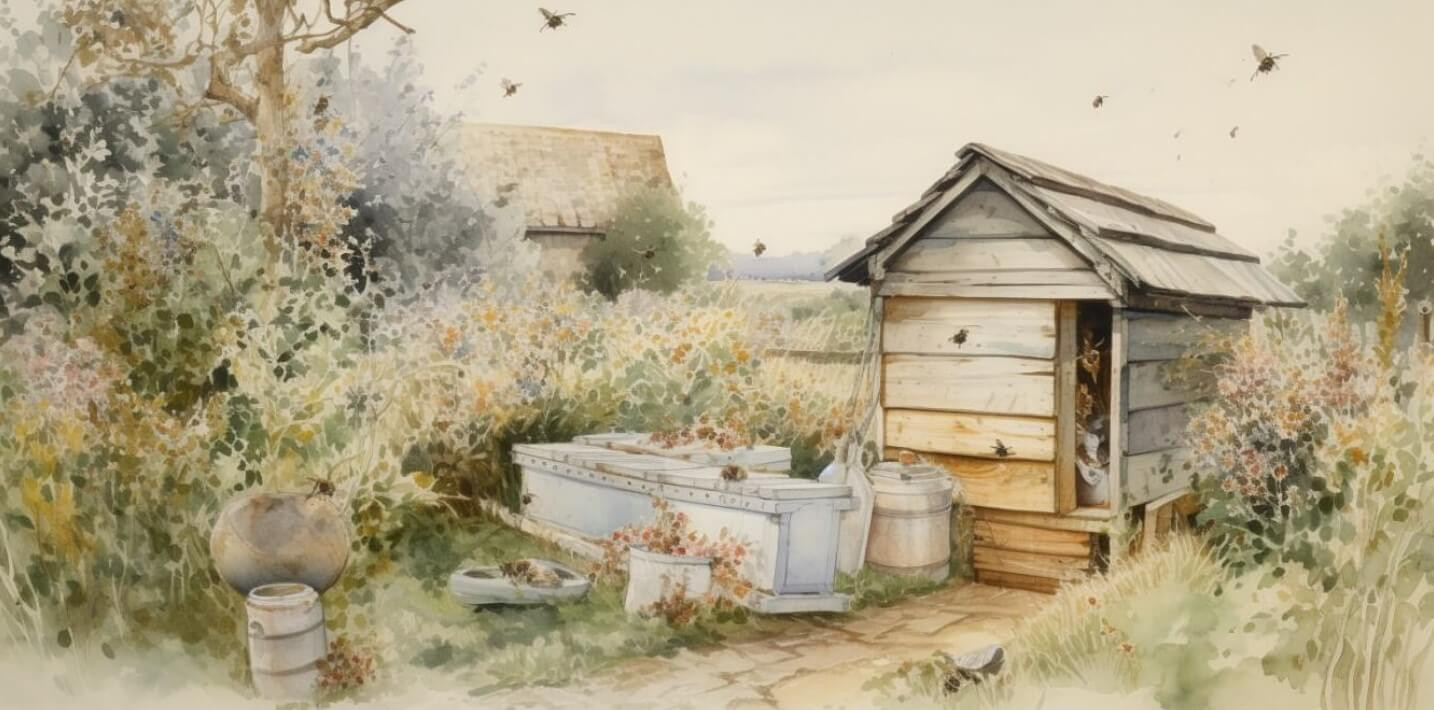Introduction
Would you prefer to listen to a short podcast discussion about this article? Click on the audio below.
The honey bee is one of the cornerstones of our ecosystem and plays a vital role in pollinating crops and producing honey. In addition, they are responsible for pollinating around 80% of the world’s plants, including fruits, vegetables, and nuts, making them essential in maintaining a healthy and diverse ecosystem. Sadly, the decline of the honey bee population in recent years is a cause for concern, and it is essential to understand the importance of honey bees and how we can help them survive.
Table of Contents
Bees are Essential Pollinators
As the primary pollinators of many of our crops, honey bees play a crucial role in our food system. Without them, we would see a significant decrease in the production of fruits, veg, and nuts. It is estimated that the honey bees contribute to producing one-third of the food we eat. Beyond their importance to our food system, honey bees also play a vital role in maintaining biodiversity and ecosystem health. Their decline could have far-reaching consequences for our planet.
The Decline of the Honey Bee
It has been known for a long while that one of the primary causes of the recent decline in honey bee populations is the use of pesticides in agriculture. These chemicals harm the bees’ nervous systems, making it difficult for them to navigate back to their hives, leading to their deaths. To help honey bees survive, we must reduce our reliance on harmful pesticides and promote the use of organic and sustainable farming practices.

The Natural Habitat
The loss of habitat is another significant threat to the survival of honey bees. As forests are cleared, and urbanization takes over, honey bees lose their natural habitats, forcing them to seek shelter in unnatural places, leading to their deaths. Planting native flowers, building bee hotels or hives, and creating a bee-friendly environment are crucial to honey bees’ survival, providing them with a place to rest, eat and reproduce.
As the world population constantly grows, the importance of honey bees as pollinators cannot be overstated. In fact, one-third of the food we eat relies on pollination by bees. Unfortunately, however, bee populations have declined recently due to habitat loss, pesticide use, and disease. Therefore, we must take action to protect these vital insects and the ecosystems they support. By implementing sustainable farming practices, reducing pesticide use, and preserving natural habitats, we can help ensure bees’ survival and their important role in our food system.
Save a Bee, Plant a Flowering Plant
Bees rely on a diverse diet of nectar and flower pollen to survive. To help honey bees thrive, we must increase their availability of food sources. Planting a variety of flowering plants or creating a community garden can provide a steady supply of pollen and nectar, allowing bees to fulfil their ecological roles as pollinators and ensure their survival.

Summary
Finally, educating people about the importance of honey bees in our ecosystem is critical. Many people are unaware of how vital honey bees are in pollinating the world’s crops and how their decline could significantly impact our food supply. Educating people on ways they can help honey bees, such as planting flowers or reducing pesticide use, can go a long way in promoting the honey bee population’s survival.
In conclusion, honeybees play a vital role in our ecosystem. Our responsibility is to protect them from ever-constant threats such as habitat loss, pesticide use, and the effects of climate change. It is estimated that the busy honey bees are responsible for pollinating one-third of the world’s crops, including fruits, vegetables, and nuts. Without them, our food supply would be severely impacted, and the cost of food would skyrocket.
Also, honey bees are essential for maintaining our planet’s biodiversity, as they play a crucial role in the reproduction of many plant species. Therefore, we must take action to protect these vital pollinators. By increasing their food sources, promoting sustainable farming practices, protecting their habitats and educating people, we can help ensure the survival of honey bees and, in turn, secure the future of our planet’s biodiversity.
If you require any assistance with this article, please do not hesitate to Contact Us
FAQ
Why are bees so important?
Bees are important because they are vital in pollinating many of the crops and wildflowers we rely on for food, including fruits, vegetables, nuts, and seeds. Without bees and other pollinators, these plants would not be able to produce the fruits and seeds they need to reproduce, which could lead to a decline in food availability and biodiversity loss. Bees also help to support other wildlife, such as birds and small mammals, by contributing to the availability of food sources.
How long do bees live?
the life cycle of the honey bee can vary depending on the type of bee. Worker honeybees, for example, typically live for 4-6 weeks during summer, with queens living for up to 5 years. On the other hand, Bumblebees generally live for a few months, with queen bumblebees surviving for up to a year. Solitary bees can have a lifespan of several months. It’s worth noting that the lifespan of bees can be affected by factors such as climate, habitat, and exposure to pesticides.
How much honey does a honey bee produce?
On average, a single honey bee can produce around 1/12th of a teaspoon of honey in its lifetime. However, a colony of honey bees can produce much larger quantities of honey. The amount of honey a colony produces depends on various factors, such as the size of the colony, the availability of nectar and pollen, and the weather conditions. A healthy colony of honey bees can produce anywhere from 30 to 60 pounds of honey in a year.
What is the honey-making process for bees?
The honey-making process for bees involves several steps. It begins with worker bees collecting flower nectar, which they store in a special stomach called a honey stomach. The nectar is then brought back to the hive and regurgitated by the worker bees into the cells of the honeycomb. The bees then use their wings to fan the nectar, which helps to evaporate the water content and thicken the liquid into honey. Once the honey has been thickened, the bees use wax to cap the cells of the honeycomb, sealing in the liquid honey until it’s needed as a food source. Finally, when the honey is required, the bees will uncap the cells with their mouths, allowing the honey to be consumed by the colony.
What are the medicinal properties of honey?
Honey has a long history of medicinal use and has been used for centuries as a natural remedy for various health conditions. Some of the medicinal properties of honey include:
1. Antibacterial and antimicrobial properties can help treat infections and promote wound healing.
2. Soothing properties can help relieve sore throat and cough symptoms.
3. Anti-inflammatory properties can help reduce inflammation and promote overall health.
4. Antioxidant properties can help protect against cellular damage and reduce the risk of chronic diseases. It’s worth noting that while honey may have some medicinal properties, it is not a substitute for professional medical care, and anyone with medical concerns should seek advice from a qualified healthcare provider.
What are the different types of honey?
There are many different types of honey, each with its own unique flavour, texture, and medicinal properties. Some examples include:
1. Manuka Honey: This type of honey is known for its strong antibacterial properties and is often used for wound healing, digestive issues, sore throat, and other conditions.
2. Eucalyptus Honey: Eucalyptus honey is said to have antiseptic properties and is often used in cough and cold remedies.
3. Clover Honey: Clover honey is a mild, sweet honey rich in antioxidants and often used to soothe sore throats and as a natural sweetener.
4. Buckwheat Honey: Buckwheat honey is dark and strong-tasting and is known for its high antioxidant content and ability to reduce cough symptoms.
5. Acacia Honey: Acacia honey is light-coloured and has a delicate, mild flavour. It’s often used to soothe upset stomachs, as it’s thought to have probiotic properties.
6. Linden Honey: Linden honey is said to have sedative properties and is often used to promote relaxation and aid sleep. It’s important to note that while honey is a natural remedy, it is not a substitute for professional medical advice and should be used in conjunction with appropriate medical care.
What is the role of the queen honey bee?
The queen bee plays a central role in the honey bee colony. She is responsible for laying eggs, which will develop into worker bees and drones, and for releasing pheromones that help regulate the colony’s behaviour and the honey bee health. The queen bee generally lays up to 1500 eggs per day during the spring and summer months, ensuring the ongoing growth and health of the colony. Her pheromones help maintain social order and ensure the colony functions efficiently. Without the queen bee, the colony will not survive for long.
Are honey bee stings fatal?
In general, bee stings are not fatal to humans unless the person is allergic to bee venom or has been stung multiple times. For people who are allergic to bee stings, a single sting can result in a severe allergic reaction that requires immediate medical attention, while for most people, a bee sting causes pain, swelling, and itching that can be relieved with home remedies or over-the-counter medications. In rare cases, multiple bee stings can result in a condition called anaphylactic shock, which is a medical emergency that requires immediate treatment. It’s important for people who know they are allergic to bee stings to carry an epinephrine auto-injector with them at all times.




















